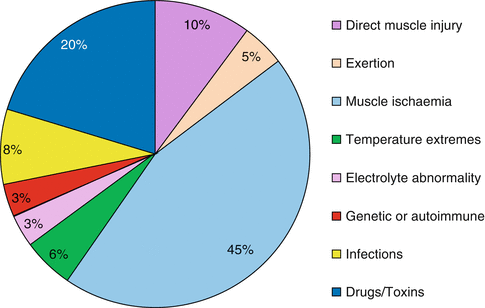and Christopher Isles2
(1)
Institute of Cardiovascular and Medical Sciences, University of Glasgow, Glasgow, UK
(2)
Dumfries and Galloway Royal Infirmary, Dumfries, UK
Q1 What is rhabdomyolysis and how does it present?
The term rhabdomyolysis describes skeletal muscle breakdown regardless of the underlying cause. Clinical presentations range from an asymptomatic incidental finding on blood or urine testing, to muscle aches with dark coloured urine (myoglobin) through to a severe illness involving AKI requiring renal replacement therapy. The frequency of AKI in rhabdomyolysis is variable, being reported at 15–50 %.
Q2 What are the causes of rhabdomyolysis?
A recent review identified three physical and six non-physical causes. The physical causes are direct muscle injury, exertion or ischaemia. The non-physical causes comprise a diverse group of conditions including temperature extremes, electrolyte abnormalities, auto-immune disease, infections, drugs and toxins. Figure 11.1 shows the causes of rhabdomyolysis in a consecutive series of 92 patients with CK >10,000 iu/L in south west Scotland.


Fig. 11.1
Causes of rhabdomyolysis in 92 consecutive patients with serum CK >10,000 iu/l (Unpublished observations)
Q3 How does rhabdomyolysis lead to AKI?
Large quantities of electrolytes, enzymes and protein (myoglobin) are released into the circulation following damage to skeletal muscle. Myoglobin is thought to be the main culprit, leading to AKI by intra-tubular cast formation and a direct cytotoxic effect, though it does not do so in every case. Some patients have very high levels of CK in their serum and do not succumb to AKI. It seems likely that both hypovolaemia and aciduria must be present for AKI to occur.
Q4 What clinical clues would make you consider rhabdomyolysis?
There are usually a few clinical pointers towards this diagnosis. The history may reveal a period of immobility due to frailty or decreased conscious level – usually in the context of drug or alcohol use. A recent infective history, the addition of a new drug likely to cause or interact with current medication to cause rhabdomyolysis or strenuous unaccustomed exercise (e.g. marathon running) should always prompt the clinician to look for evidence of muscle damage. Visibly dark urine (“coke-coloured”) is likely to be caused by myoglobinuria in the context of a compatible history. Incidentally, myoglobinuria will test positive for blood on the urine dipstick test without there being any red blood cells on microscopy
The cause of rhabdomyolysis in the following case history was a previously unsuspected drug interaction between atorvastatin and fusidic acid, diagnosed on the basis of muscle weakness and grossly raised CK. The patient was oligoanuric at the time so that it was not possible to test for myoglobinuria.
Case Report
A 69 year old man presented with multi organ failure secondary to left lower lobe consolidation for which he required ventilation, dialysis and inotropic support. One week previously he had been prescribed flucloxacillin 2 g per day and fusidic acid 2.25 g per day following the excision of an infected hip prosthesis. He had a myocardial infarction previously and his routine medications included atorvastatin 40 mg per day. We were able to withdraw ventilatory and circulatory support after 3 days, although the patient remained dialysis dependent and slow to mobilise. We observed at this point that he could not sit up unaided and went on to demonstrate proximal muscle weakness with serum CK 21,652 iu/l (normal range 0–195). Both atorvastatin and fusidic acid were stopped. The patient was unable to walk for a further 4 days and remained dialysis dependent for another 10 days. When reviewed at the clinic 2 months after his initial presentation muscle power had returned to normal and serum creatinine was 105 μmol/l.Teckchandani, et al. Rhabdomyolysis following co-prescription of fusidic acid and atorvastatin. J R Coll Phys Edinb. 2010;40:33–6; with kind permission of the Royal College of Physicians of Edinburgh
< div class='tao-gold-member'>
Only gold members can continue reading. Log In or Register to continue
Stay updated, free articles. Join our Telegram channel

Full access? Get Clinical Tree








